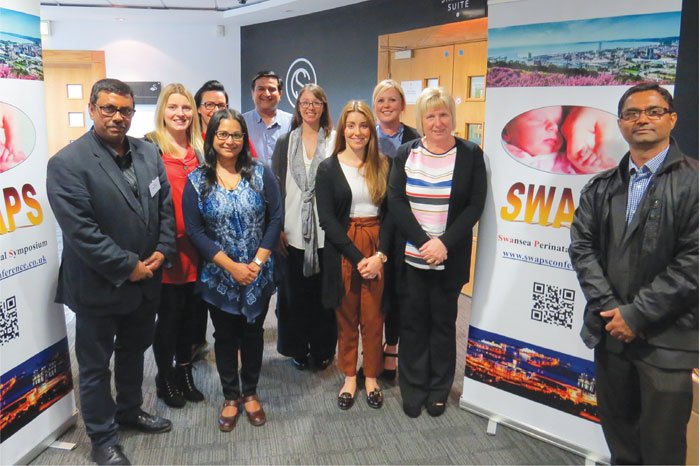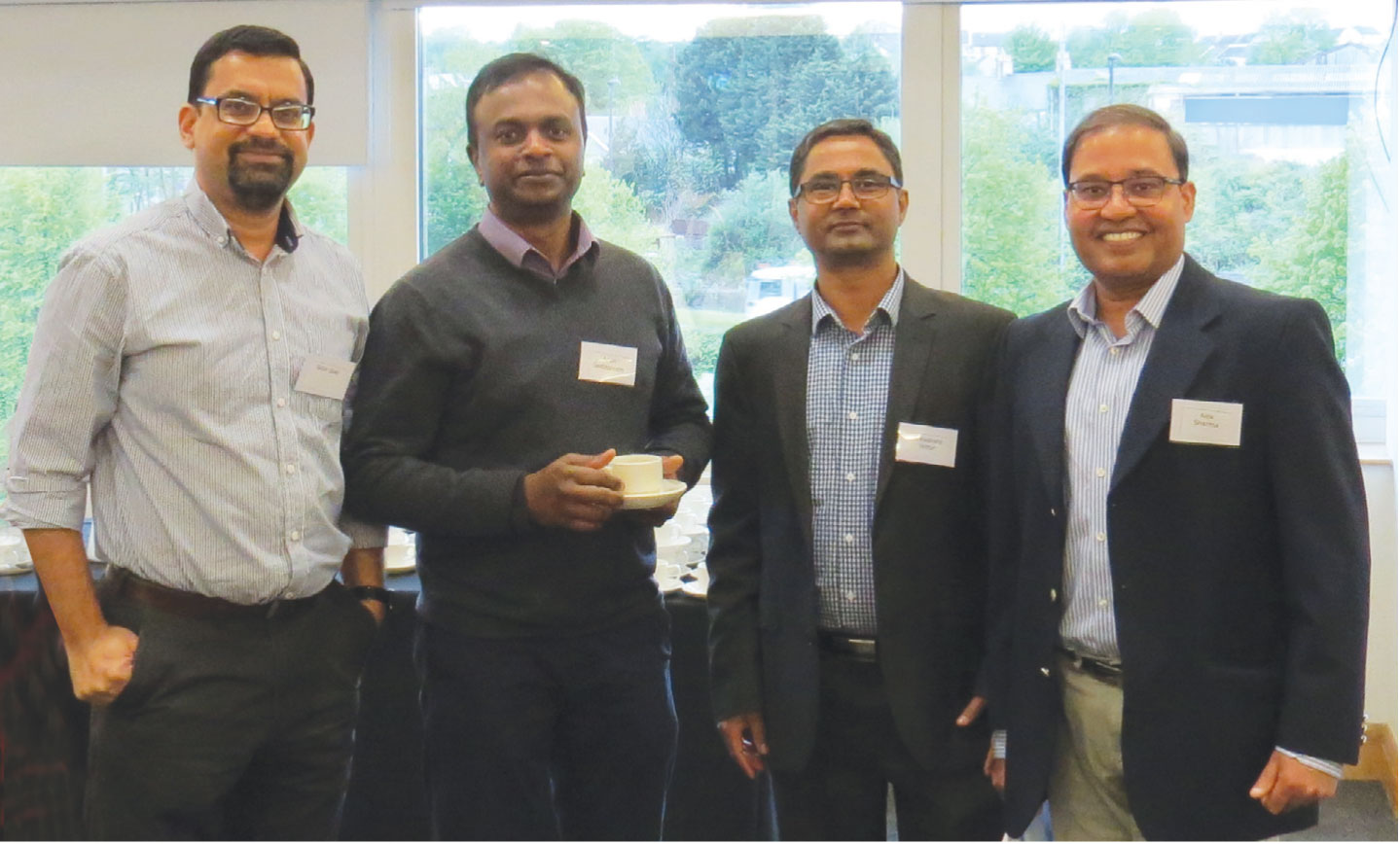Extending horizons in perinatal medicine: The fifth Swansea Perinatal Symposium (SWAPS 2019)
Delegates from neonatal, paediatric, obstetric and midwifery disciplines gathered at the Liberty Stadium in Swansea for the fifth Swansea Perinatal Symposium (SWAPS). Building on its success over the past few years, the conference invited speakers that are leaders in their field from Europe, the UK and the Middle East, while staying true to its aim of providing high quality but affordable educational opportunities for attendees. The symposium offered delegates an extended plenary session, breakout sessions in neonatology and obstetrics as well as a scientific forum for poster and oral presentations.
Huw Davies
ST5 Paediatrics
Consultant Obstetrician and Gynaecologist Sujoy Banerjee
Consultant Neonatologist
Singleton Hospital, Swansea, Wales
Plenary session 1
Professor Frances Cowan, Visiting Professor of Perinatal Neurology, University of Bristol, gave an overview of perinatal stroke focusing particularly on risk factors, accurate prognostication from advanced imaging and its implications for clinical and medicolegal practice. She emphasised that the week of birth poses the greatest risk for ischaemic stroke. Ischaemic stroke is multifactorial with a complex interplay of maternal, fetal, intrapartum and postnatal risk factors. Males are at greater risk and 70-80% of lesions affect the left middle cerebral artery territory. Although there is an association with a number of intrapartum factors such as maternal pyrexia, prolonged rupture of membranes, prolonged second stage of labour and emergency caesarean section, it is not clear if preventative strategies can be effective without increasing other morbidities. One of her key messages was that interpretation of brain imaging should allow accurate and customised prognosis.
Dr Jean Matthes, Consultant Neonatologist at Singleton Hospital Wales, presented the WHO guidance aimed at elimination of perinatal hepatitis B and C by 2020. Chronic hepatitis C is now treatable with once daily oral combination therapy, replacing the use of interferon and with significant cost savings. However, the problem lies in early identification with 34% of the intravenous drug users in pregnancy unaware of their hepatitis C virus status. There is a new recommendation for more extensive screening. Hepatitis B has distinct regional genotypes with corresponding variation of prognosis. Vertical transmission occurs in utero and especially at birth and therefore identification and vaccination of at-risk infants is vital to prevention. Importantly, breastfeeding does not increase risk of transmission and it is safe to breastfeed while taking antivirals such as tenofovir.

The organisers of SWAPS 2019. From left, Sujoy Banerjee, Rhiannon Cronin, Madhuchanda Dey, Gemma Davies, Amit Kandhari, Emma Mugford, Rachel Dykes, Sarah Madden, Helen Banks and Sreedhar Nittur.
Plenary session 2
Professor Jan Deprest of University Hospital Leuven, Belgium, gave a fascinating presentation outlining the latest developments and outcomes of fetal surgery for spina bifida. Spina bifida is an embryological defect arising from failure of neurulation of the spinal cord and is progressive during fetal life. Most importantly, in addition to the development of the hydrocephalus, it is also associated with progressive atypical changes in the developing brain. The problem is detectable from 13 weeks for the brain findings, or 19 weeks for the spine. Earlier in utero closure of the fetal defect may arrest the progression of these changes but there is risk of miscarriage, premature labour and future obstetric complication from an uterotomy. Balancing these risks, the optimal window for fetal surgery is currently 24-26 weeks’ gestation. Fetoscopic surgery might have potential in the future, but at present it is associated with high failure rates, high rates of prematurity, and high rates of perinatal death.
The keynote lecture came from Professor Jose Villar, Professor of Perinatal Medicine, Nuffield Department of Women and Reproductive Health, University of Oxford. He described the limitations of current cross-sectional growth charts created using birth weights that assume postnatal growth mimics fetal growth. However, fetuses and newborn preterm infants have differently controlled metabolic and growth patterns. Professor Villar is the Chief Investigator of the Intergrowth-21st study, which represents a paradigm shift and describes an international standard of how fetuses, newborns and infants should grow longitudinally when nutritional, environmental and health constraints on growth are minimal. Through an array of fascinating charts he demonstrated that variations in skeletal and organ growth are larger within a population than between populations, when nutrition and health needs are met. This is consistent with the conclusion from the genomic project that the concept of race has no genetic or scientific basis. Our approach to growth should not simply track weight gain but aim for optimal body composition by minimising exposure to overfeeding and adiposity.
Plenary session 3
The post-lunch afternoon session started with an inspiring story from Andrea Duckworth and her family. She described the family’s journey of overcoming disability and the factors that helped build their resilience. In 1996 her first child was admitted to a neonatal unit with a brain haemorrhage and was not expected to survive. Now aged 23, he spoke eloquently about his journey and struggles through childhood and into early adulthood, driving a car, employment and personal plans for the future. As the founder of Enabling Ability, Andrea is passionate about helping others overcome challenges, particularly those who have a disability or long-term medical condition.
A world expert in hyperinsulinaemic disorders in newborns, Professor Khalid Hussain, Division Chief of Endocrinology, Sidra Hospital, Doha, and Honorary Professor, University College London, provided an excellent overview of the condition and recent advances in manag-ement. While most hyperinsulinaemic disorders are transient, those with under-lying genetic and cell membrane transporter defects are extremely challenging to manage.

Delegates at SWAPS 2019. From left, Drs Nitin Goel, Arun Sadasivam, Sreedhar Nittur and Alok Sharma.
Dr Sari Ahlqvist-Björkroth from the University of Turku in Finland presented updated research on family nurture interventions, aimed at improving family bonding and neurodevelopmental outcomes. As part of the programme, the team provides in-depth training and cot-side evaluation for the entire neonatal unit staff over a period of 18 months. Parents are encouraged to observe infant behaviour, and maintain a ‘closeness diary’ noting their interactions. In addition to anticipated benefits for neonatal outcomes, they have seen a large reduction in maternal depression during the initial monitoring period and at two-year follow-up.
Mr Prabhu Sekharan, Consultant Paediatric Surgeon from the University Hospital of Wales, presented practical evidence-based recommendations for neonatal surgical conditions. In the last decade, paediatric surgery has seen very little in terms of high quality research publications. He provided an overview on the management of diaphragmatic hernia, sacrococcygeal teratoma, anorectal malformations, and necrotising enterocolitis. Management of the newborn with bilious vomiting remains a challenge for paediatricians without on-site access to surgeons. Only 10% go on to receive a ‘surgical’ diagnosis and 6% need laparotomy, however identifying those which require intervention invariably necessitates an upper GI contrast and follow through. He also presented evidence regarding timing of operation for inguinal hernia – recurrence is higher for preterm infants, and it makes little difference whether surgery occurs before or after discharge. However, managing the risks around unanticipated obstruction is another source of unresolved uncertainty.
Obstetric break-out session
Professor Dame Tina Lavender, Professor of Midwifery and Director of the Centre for Global Women’s Health at the University of Manchester, offered a global perspective when she presented her research on innovative interventions in stillbirth prevention and management in sub-Saharan Africa. Nearly 98% of stillbirths occur in low and medium income countries, half of these in the intrapartum period. Her research focused on improving childbirth care by examining factors that influence how women seek and access care, the quality of the care received including identification of women with high-risk pregnancies, and the specific causes of stillbirth in local healthcare facilities. A global team effort is required to train health professionals, to ensure systems and processes are responsive to individual needs and culturally sensitive and tailored to the needs of the community.
Dr Michael Robson from The National Maternity Hospital in Dublin presented his views on increasing caesarean section (CS) rates. He argued that CS rate is the fulcrum that relates directly or indirectly to all obstetric and neonatal outcomes and organisational issues. He argued that the overall rate of CS on its own is less relevant. It is only when we study it in the context of other outcomes of labour and delivery that its relevance becomes clearer. CS is a major operation that has clinical, social and economic implications, yet there is no universally used classification that identifies women who are most likely to have a CS and its effect on short and long-term implications for both mother and baby. He argued that as professionals, the biggest criticism we will face in the future is not that the CS rate was allowed to increase but that we made no effort to study it scientifically.
Professor Robert Freeman of Queen’s Medical Research Institute, Edinburgh, presented his views on prevention of maternal birth trauma and its conse-quences. Birth trauma can lead to chronic pain, problems with bonding and establishing breastfeeding, long-term bladder and bowel problems, sex and relationship difficulties, tokophobia, postnatal depression and post-traumatic stress disorder. A large proportion of these problems are being seen in the younger population and the risk is increasing because of changing maternal demography – older primips, diabetic mothers, bigger babies etc. Professor Freeman highlighted the importance of appropriate antenatal risk assessment to identify women at risk of birth related perineal trauma. These individual risks should be discussed with women so that they can make an informed choice about their preferred mode of delivery.
There were a number of high quality poster presentations. The Best Abstract prize went to Kayleigh Gibbs, a medical student from University of Exeter for her case control study on maternal and infant risk factors influencing outcomes of water-birth deliveries. The Best Poster Presentation award went to Sophie Renwick from the PROMPT Wales Implementation team.
The symposium was attended by nearly 200 delegates and 19 commercial exhibitors, highlighting the growing enthusiasm around this conference. The sixth Swansea Perinatal Symposium is provisionally scheduled for 21 May 2020 at the Liberty Stadium.
Or read this article in our
Tablet/iPad edition


